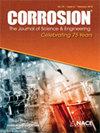Galvanic Interactions on a Coupled Micro-Electrode Array of AA7050-T7451 and 316SS in Chromate-Containing NaCl Solutions Under Thick Electrolyte Film and Cyclic Wet-Dry Conditions
IF 1.3
4区 材料科学
Q4 MATERIALS SCIENCE, MULTIDISCIPLINARY
引用次数: 0
Abstract
Abstract The electrochemical behavior of an AA7050-316SS galvanic couple in chromate-containing NaCl environments under relatively constant thick electrolyte films and wet-dry cycling was investigated utilizing the coupled micro-electrode array (CMEA) approach. The CMEA approach provided a means to analyze the in-situ electrochemical kinetics as a function of spatial location and time. In inhibitor-free environments, the total net anodic charge associated with galvanic current increased with increasing conductivity and aggressiveness of the environment. The AA7050 electrodes supplied more than half of the total net cathodic charge in relation to the 316SS electrodes in the more aggressive environments. Under thick electrolyte films, chromate became less effective at suppressing cathodic kinetics on the 316SS and AA7050 net cathodes as the chloride concentration increased. Under wet-dry cycling conditions, the effectiveness of chromate was diminished when compared to thick electrolyte film conditions, due to the cycling of the equilibrium chloride concentration as electrolyte thickness changed upon onset of drying and wetting while the loading density of the salt remained constant. Furthermore, chromate exhibited a diminished ability to suppress cathodic currents on the AA7050 net cathodes in comparison to the 316SS electrodes. This study highlighted the importance of Cu-rich intermetallic particles and replated Cu on precipitation-strengthened Al alloys when considering the driving force of cathodes in sustaining anodic dissolution in typical Al alloy macro-galvanic systems exposed to atmospheric conditions.厚电解质膜和循环干湿条件下AA7050-T7451和316SS耦合微电极阵列在含铬NaCl溶液中的电相互作用
摘要:采用耦合微电极阵列(CMEA)方法研究了AA7050-316SS电偶在相对恒定厚电解质膜和干湿循环条件下在含铬NaCl环境中的电化学行为。CMEA方法提供了一种分析原位电化学动力学作为空间位置和时间函数的方法。在无抑制剂的环境中,随着环境的电导率和侵蚀性的增加,与电流相关的总净阳极电荷增加。在更恶劣的环境中,与316SS电极相比,AA7050电极提供了超过一半的净阴极电荷。在较厚的电解质膜下,随着氯离子浓度的增加,铬酸盐对316SS和AA7050净阴极的阴极动力学抑制作用减弱。在干湿循环条件下,与厚电解质膜条件相比,铬酸盐的有效性降低了,这是由于在干燥和湿润开始时,平衡氯浓度随着电解质厚度的变化而循环,而盐的负载密度保持不变。此外,与316SS电极相比,铬酸盐在AA7050净阴极上抑制阴极电流的能力减弱。本研究强调了富Cu金属间颗粒和Cu在沉淀强化铝合金上的重要性,当考虑到典型铝合金暴露于大气条件下的宏观电偶体系中阴极维持阳极溶解的驱动力时。
本文章由计算机程序翻译,如有差异,请以英文原文为准。
求助全文
约1分钟内获得全文
求助全文
来源期刊

Corrosion
MATERIALS SCIENCE, MULTIDISCIPLINARY-METALLURGY & METALLURGICAL ENGINEERING
CiteScore
2.80
自引率
12.50%
发文量
97
审稿时长
3 months
期刊介绍:
CORROSION is the premier research journal featuring peer-reviewed technical articles from the world’s top researchers and provides a permanent record of progress in the science and technology of corrosion prevention and control. The scope of the journal includes the latest developments in areas of corrosion metallurgy, mechanisms, predictors, cracking (sulfide stress, stress corrosion, hydrogen-induced), passivation, and CO2 corrosion.
70+ years and over 7,100 peer-reviewed articles with advances in corrosion science and engineering have been published in CORROSION. The journal publishes seven article types – original articles, invited critical reviews, technical notes, corrosion communications fast-tracked for rapid publication, special research topic issues, research letters of yearly annual conference student poster sessions, and scientific investigations of field corrosion processes. CORROSION, the Journal of Science and Engineering, serves as an important communication platform for academics, researchers, technical libraries, and universities.
Articles considered for CORROSION should have significant permanent value and should accomplish at least one of the following objectives:
• Contribute awareness of corrosion phenomena,
• Advance understanding of fundamental process, and/or
• Further the knowledge of techniques and practices used to reduce corrosion.
 求助内容:
求助内容: 应助结果提醒方式:
应助结果提醒方式:


